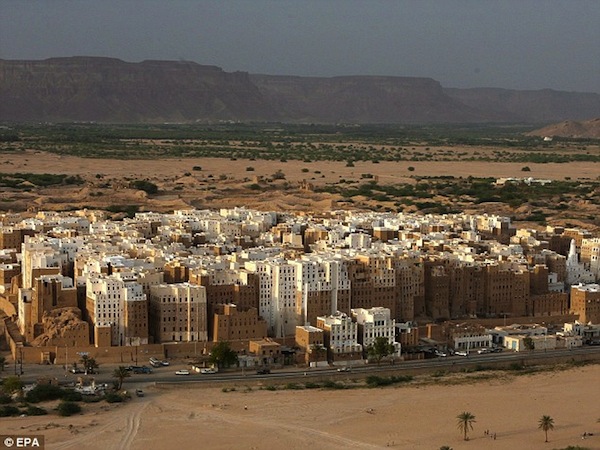Blog
September 22, 2012
Shibam 'Manhattan Of The Desert': The First Green Skyscrapers In The World
Skyscrapers are not new inventions of the post-industrial world, they are as old as 500 years ago. Shibam, a city in the desert of Yemen, is commonly known as the Manhattan of the desert.
Many centuries before the modern age of skyscrapers in the United States and Europe, Yemen in the Arabian Peninsula built its own skyscraper in the city of Shibam. It is a city in the eastern desert of Yemen, and commonly known as ‘the Manhattan of the desert’. Shibam represents one of the oldest vertical and daring residential buildings, which established an outstanding example of remarkable human settlement and land use. Rising high towards the sky, Shibam’s houses are remarkable symbols of socio-economic and political factors as well as an expression of the wealth of the rulers.
The origins of Shibam dates back to pre-Islamic times. It is believed that city was completely destroyed by the Himyarites in the fourth century and nothing survived from this early period. However, the existing Friday mosque and the castle date from the reign of Harun al-Rashid. The city of Shibam is characterized by its dark narrow streets and tunnels between the brown high-rise buildings, with masonry drains in the street. One also can recognize an exciting juxtaposition between the white mosque and the high houses. In the west of Shibam, there are number of wealthy districts, which feature distinctive doors and windows made out of carved wood.
Unlike the glass curtain wall and steel structure of the progressed modern skyscrapers, Shibam’s distinct buildings were built out of sun-dried, mud-brick, load-bearing walls by traditional method of construction. Shibam’s imposing high-rise buildings consist of many floors, which are as high as fourteen stories and parts of these buildings date back to thousands years. The 7000 inhabitants of Shibam conceived the idea of building upwards, which can truly be considered innovative at the time, and created the world’s first environmentally friendly skyscrapers. The City of Shibam became a World Heritage city over 20 years ago, and this has at least helped preserve both the buildings and aspects of the regional culture that might otherwise have been lost.

Buildings inside the high-rise town of Shibam, Wadi Hadhramaut (or Hadhramout, Hadramawt) Yemen, with traditional windows and doors. (Photo credit: Wikipedia)
The concept of building the traditional skyscrapers depends on realizing a natural regulated interior environment, while being locked out to the exterior environment in order to achieve the desired human comfort. In addition, the mud-brick, as a natural building material provides a considerable insulation from the heat of the sun. However, these skyscrapers represent an early introduction to the principles of environmentally sustainable design and green buildings.
Via : Knoji
Tags:
Connect With Us
Related Posts
- Real Estate Act comes into effect: 10 things you need to know about new law ( May 4, 2017 )
- Expats Living in Comfort – Hyderabad, India ( May 4, 2017 )
- MNC queue to Hyderabad grows longer; JP Morgan & IBM look for office space ( June 22, 2016 )
- An Apple in Hyderabad’s IT Garden: CEO Tim Cook’s big announcement Today ( May 19, 2016 )
- Hyderabad May get Disneyland Park ( April 22, 2016 )
- Indian Office Space Absorption Up 11% in Q4: Survey ( April 13, 2016 )
- Cognizant plans to add 8,000 people at Hyderabad facility ( March 9, 2016 )
- Ranked 139 in world, Hyderabad is Best Indian City to Live in ( February 24, 2016 )
- The Platina – Exclusive Commercial Space, Hyderabad ( February 19, 2016 )
- Apple, Inc set to open new $25 million Tech Center in Hyderabad, India by June ( February 16, 2016 )
Recent Posts
Recent Comments
Archives
- February 2018
- October 2017
- May 2017
- June 2016
- May 2016
- April 2016
- March 2016
- February 2016
- January 2016
- December 2015
- November 2015
- October 2015
- July 2015
- June 2015
- May 2015
- April 2015
- March 2015
- February 2015
- December 2014
- November 2014
- October 2014
- September 2014
- August 2014
- July 2014
- June 2014
- May 2014
- April 2014
- March 2014
- February 2014
- January 2014
- December 2013
- November 2013
- October 2013
- September 2013
- August 2013
- July 2013
- June 2013
- May 2013
- April 2013
- March 2013
- February 2013
- January 2013
- December 2012
- November 2012
- October 2012
- September 2012
- August 2012
- July 2012
- June 2012
- May 2012
- April 2012
- March 2012
- February 2012
- January 2012
- December 2011
- November 2011
- October 2011
- September 2011
- July 2011
- June 2011
- May 2011
- March 2011
- November 2010
- October 2010
- September 2010
- August 2010
- July 2010
- May 2010
- April 2010
- March 2010
- February 2010



Leave a reply